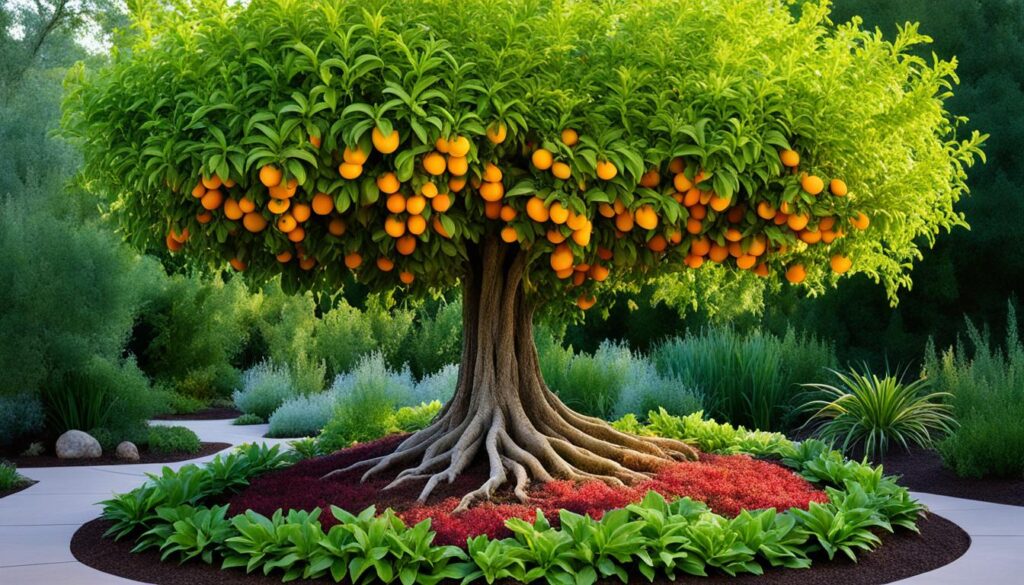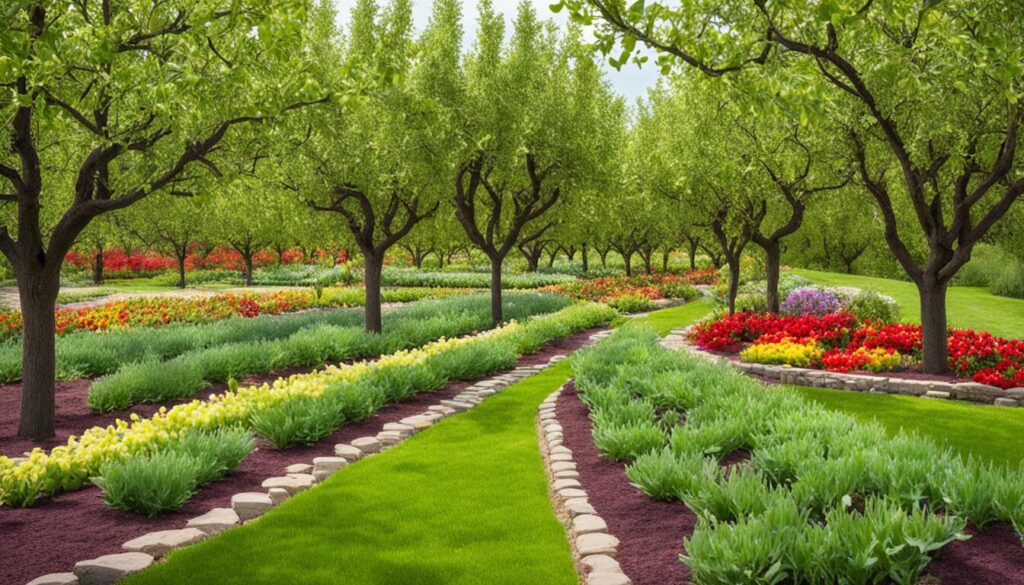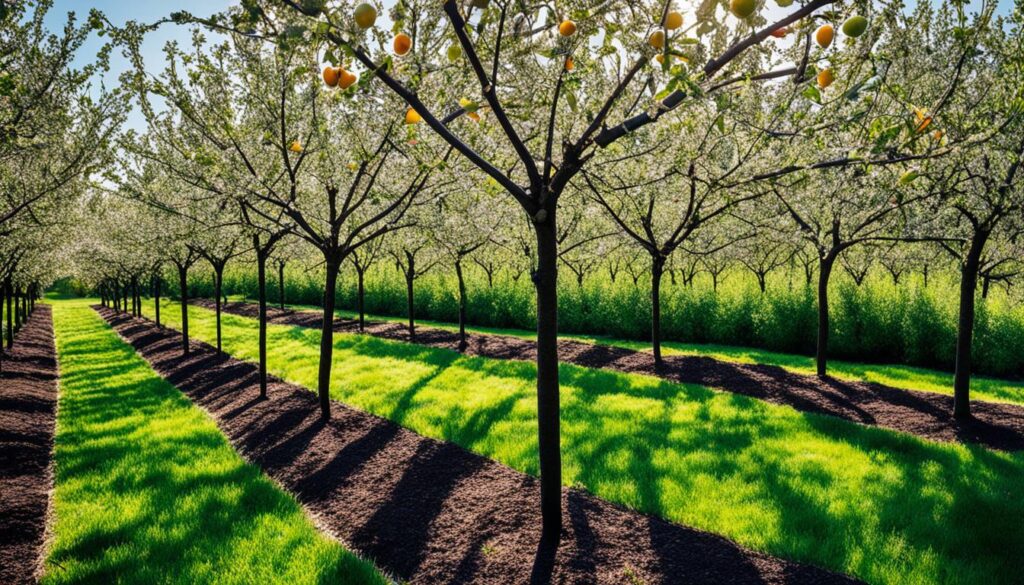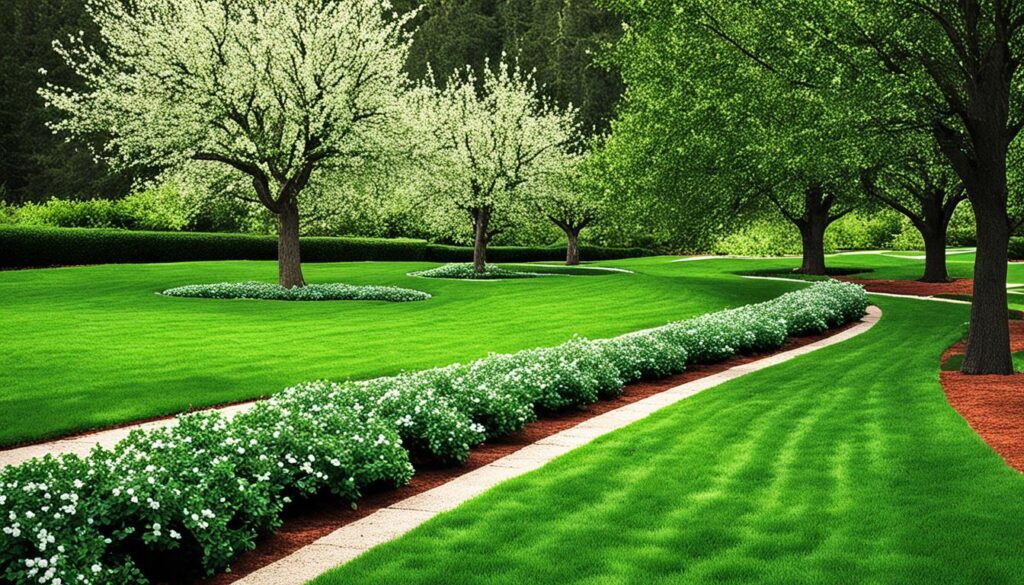Ever thought about making your fruit tree orchard a pest-free paradise? The key is in fruit tree companion planting. By mixing different plants around your trees, you create a mini-ecosystem. This system keeps pests away, boosts nutrients, and draws in good bugs. But starting can be tricky.
This guide will show you the ropes of fruit tree companion planting. We’ll talk about the perks of a polyculture or guild around your trees. You’ll learn how to pick the best plants and where to put them. Get ready to elevate your fruit tree care.
What is Companion Planting?
Companion planting, also known as guild planting, is a way to grow different plants together around fruit trees. It makes a miniature ecosystem or polyculture. This method helps improve the health and productivity of the orchard.
Interplanting Diverse Plants Around Fruit Trees
By mixing different plants, companion planting draws in good insects, keeps weeds down, fixes nitrogen, and offers other benefits. This method creates a balanced and healthy interplanting system around fruit trees.
Creating a Polyculture or Guild for a Miniature Ecosystem
The aim of companion planting is to build a polyculture or guild like a tiny ecosystem. This method copies the natural links and dependences in healthy plant groups. It makes the orchard more resilient and productive.

By picking and placing companion plants carefully, gardeners boost the natural processes in the orchard. This leads to better fruit quality, more pest resistance, and a greener growing system.
Best Places to Plant Companions
Choosing the right spots for fruit tree companions is key. Think about where to put these plants to get the most benefits. This way, you make a healthy, balanced garden.
Orchard Rows
Spaces between fruit trees are great for planting companions. These plants can be trimmed back, so they won’t compete with your trees.
Hedges
A diverse hedge around your orchard boosts biodiversity. It also gives a home to helpful insects and wildlife. Hedges protect your fruit trees too.
Pollinator Gardens
Creating a pollinator garden near your orchard is smart. It gives bees and butterflies pollen and nectar. This means better pollination for your trees and more fruit.
Field’s Edge
The edge of your orchard meets the field, making a special place. Planting companions here makes a lush, productive area.
Wet Areas
If your orchard has wet spots, use them for plants that love water. This makes your garden self-sustaining and full of life.
Putting your fruit tree companions in these spots boosts their benefits. This makes your orchard strong and healthy.

The Functions of Orchard Companions
Creating a thriving orchard needs the right plants together. These plants help your fruit trees grow strong and healthy. They make your orchard fight off pests and diseases better. They also help with biodiversity and nutrient cycling.
Companion plants draw beneficial insects that eat pests. They give these insects food and homes. This way, you don’t need harmful chemicals to control pests. Some plants even keep pests away by their smell.
These plants also make the soil better. Some bring up minerals from deep in the soil. Others turn air nitrogen into a form your trees can use. This means you use less synthetic fertilizers.
Companion plants help fight weeds too. They act like a living mulch, stopping weeds and keeping soil moist. This means you don’t have to mow or till as much. It keeps your orchard’s ecosystem healthy.
Choosing and placing different plants wisely makes your orchard strong and full of life. It needs little care but gives lots of fruit every year.

Food and Medicine for Beneficial Insects
Companion planting helps your fruit trees grow strong and healthy. It also brings in beneficial insects that keep your orchard balanced. Plants like dill, coreopsis, phacelia, and buckwheat are great for these helpful bugs.
Dill
Dill is a favorite of many beneficial insects. It draws in ladybugs, lacewings, aphid midges, and tachinid flies. These insects eat pests that harm your fruit trees.
Coreopsis
Coreopsis is a bright flower that’s great with fruit trees. Its flowers feed bees and butterflies. They also attract insects that eat pests.
Phacelia
Phacelia, or «Lacy Phacelia,» grows fast and blooms with small, blue-purple flowers. These flowers are a hit with lacewings, hoverflies, and parasitic wasps.
Buckwheat
Buckwheat is a good match for fruit trees. Its small flowers attract ladybugs, pirate bugs, and predatory mites. These insects help keep your orchard pest-free.
Adding these plants to your fruit trees makes your orchard a great place for beneficial insects. This means fewer pests and more delicious fruit. With some planning, your orchard can be a haven for these helpful bugs.

Ground Covers
Many ground covers don’t do well under fruit tree canopies because of shade, traffic, and fallen fruit. But, some species can really stand out in the orchard understory. Arnica, Selfheal, and Violets are great because they’re low-growing and can handle shade. They also help keep weeds down without fighting with the trees too much.
Arnica
Arnica is a wildflower that grows into dense mats and likes partial shade. Its bright yellow flowers draw in helpful insects. Plus, it has healing properties that make it great for any orchard.
Selfheal
Selfheal, or Prunella, is a low-growing herb that does well in the shade under fruit trees. It has purple flowers that bees and butterflies love. For years, people have used it in herbal medicine.
Violets
Violets are perfect for orchards because they like shade and spread out a lot. These tiny flowers give nectar to good insects. They also help keep weeds away.
Adding these tough ground covers to your fruit tree orchard makes it more diverse and healthy. It helps your trees stay strong and full of life.

fruit tree companion planting
Fruit tree companion planting means putting different plants together around your fruit trees. This way, you make a garden that helps your fruit trees grow strong and healthy. You don’t need to use chemicals.
Choosing the right plants is key. Herbs, flowers, trees, vegetables, berries, and mushrooms can help your orchard. They attract good bugs, keep away bad ones, and give nutrients and mulch.
For lots of fruit, you need plants that help with pollination. Add herbs and flowers near your trees. A mix of plants also fights pests and diseases, cutting down on harmful sprays.
Think about what each fruit tree needs when picking companions. Some plants work great with apples, others with citrus or stone fruits. Use a guide or eBook to find the best matches for your orchard.
Balance and working together are important for a strong fruit tree guild. Plant your trees with other plants that help them. This makes a garden that’s good for your trees and full of life for many years.
Six Categories of Fruit Tree Guild Plants
Creating a fruit tree guild means picking plants that work well together. There are six main types of plants for this. Each type has a special job to help your orchard grow strong and healthy.
Suppressors
Suppressor plants stop weeds from growing around fruit trees. Strawberries, clover, and mint are good examples. They keep the area clean and ready for your fruit trees.
Attractors
Attractor plants bring in good bugs like pollinators and pests’ enemies. Lavender and yarrow are great for this. They make your fruit tree guild healthier and more productive.
Repellers
Repeller plants keep away bad pests and bugs. Garlic and marigold are good at this. They help keep your fruit tree guild balanced and strong.
Mulchers
Mulcher plants add organic matter to the soil. This helps the soil stay moist and rich. Comfrey and borage are good mulchers for your fruit tree guild.
Accumulators
Accumulator plants pull nutrients from the soil and share them with other plants. Yarrow, chicory, and dandelion are good at this. They make your fruit tree guild more nutritious.
Fixers
Fixer plants turn air nitrogen into a form plants can use. Clover, beans, alfalfa, and peas are great for this. They make your fruit tree guild more fertile.
Using plants from these six groups makes a fruit tree guild thrive. It creates a healthy ecosystem. It also cuts down on the need for extra help and makes your orchard more productive.
Considerations for Planting Companions
When adding companion plants to your orchard, think about a few things. Don’t plant them too close to the tree trunks. They might fight for the same resources. It’s better to plant them in groups or masses.
Also, watch out for plants that spread a lot and need upkeep. Some, like Horsetail, can be hard to get rid of once they’re there. Your goal is to make an orchard that’s balanced and easy to take care of, helping your fruit trees grow well.
Proper Spacing and Placement
Permaculture says to keep plants about 1m away from the tree trunk. This stops them from fighting over resources. It lets the companions grow well and help your trees.
Planting in groups or masses works best. It draws in more beneficial insects and makes a better ecosystem.
Choosing the Right Companions
When picking companion plants, think about how they grow and spread. Some, like Comfrey, are super helpful but might need extra care to stay under control.
Other plants, like Daffodils and Chives, help keep pests away and attract pollinators. They don’t spread too much. By choosing the right plants, you make a garden that’s healthy and easy to look after, helping your fruit trees do great.
| Companion Plant | Benefits | Considerations |
|---|---|---|
| Comfrey | Deep rooting system, nutrient cycling, insect attraction | Aggressive growth, may require maintenance |
| Daffodils | Pest deterrence, pollinator attraction | Easy to manage, low maintenance |
| Chives | Insect repellent, pollinator attraction | Compact growth, easy to integrate |
Top Companion Plants for Orchards
Choosing the right plants for your orchard is key to success. The best plants vary by region and fruit tree type. Yarrow, Baptisia, Chives, Comfrey, Daffodils, Dogwoods, Horsetail, Hyssop, Sweet Cicely, and Tansy are great choices. They help by drawing pollinators, fighting pests, and adding nutrients to the soil.
Nitrogen-fixing plants like Lupines and Dalea add nutrients to the soil. Plants like Yarrow and Dandelion also make the soil richer. These plants attract bees and birds, which is good for your fruit trees.
Think about what each plant needs when planning your orchard. Consider their water needs, how deep their roots go, and how they work with your fruit trees. With the right plants, your orchard will be healthy and productive.



